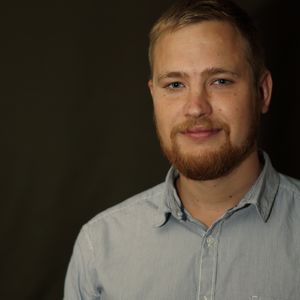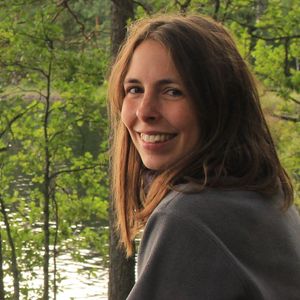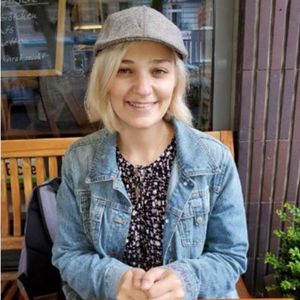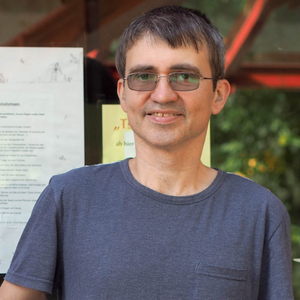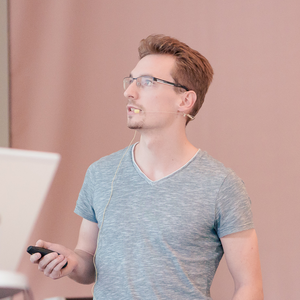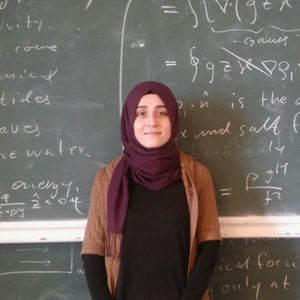Reports
Research Stay in Perth by Mira Schmitt (Oct 23)
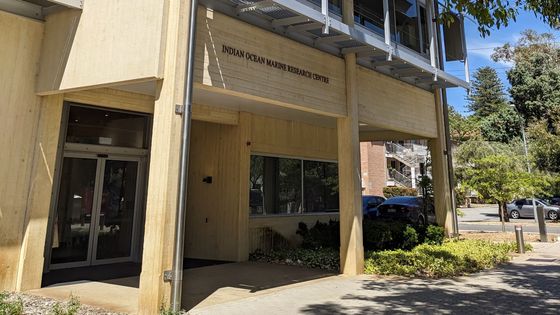
At the end of last year, I spent two months in Perth, Western Australia, to work on a collaborative project with Jen-Ping Peng, who was a PhD in TRR181’s first phase and is now a PostDoc in the working group of Nicole Jones at the Indian Ocean Marine Research Centre of the University of Western Australia. For the most part, my stay in Perth was covered by the Australia–Germany Joint Research Cooperation Scheme, with the TRR kindly providing some additional financial support. The above scheme is an initiative of Universities Australia and the German Academic Exchange Service (DAAD) for the support of international academic cooperation. Early-career researchers from Australia and Germany are encouraged to hand in proposals for a joint research topic, and, if approved, the grant covers the expenses for a research stay at the partner institute. For our project, Jen-Ping and I decided that we want to combine our two fields of research and investigate the interactions of diurnal warm layers, submesoscale fronts and other turbulent processes in the surface mixed layer. For this, we firstly extended the 1D turbulence model GOTM to include 3D frontal effects and validated our model results by comparing them to published LES studies. Then, we used our model to recreate measurements taken previously during two campaigns in the Baltic Sea and the Indian Ocean and use the results to understand the governing processes involved. We found nice agreements between the measurements and our simple model and are planning on publishing two joint papers on these topics.
But besides the work aspect, Western Australia was also a great place to explore and spend time. Jen-Ping was an excellent host (I think we went to every great Asian restaurant in all of Perth) and the weather was pleasant from beginning to end (basically nothing but sunshine for two months). I stayed in a researcher accommodation on campus, which is located a few kilometres away from the city centre directly at the Swan river estuary with lots of green areas and beautiful old trees. Moreover, I got to go on two nice road trips up and down the coast, explore the Margaret River wine region, see quokkas on Rottnest Island and snorkel in the beautiful Ningaloo Reeve national reserve with an infinite amount of fish, stingrays and even a big sea turtle. I also got to see a living colony of stromatolites, microorganisms that are believed to be the oldest form of life on earth dating back 3 billion years, and that can only survive in hypersaline estuaries like Shark Bay in Western Australia. And while there were a few snake and spider sightings, I didn’t have the heart to look up their level of toxicity, so I like to believe it was all safe and sound.
I can definitely recommend looking into the Joint Research Cooperation Scheme (it exists not only between Germany and Australia, but also other countries) and would strongly encourage others to take the opportunity to extend their network and travel, maybe to Perth, it’s a lovely corner of the world. I would like to thank Jen-Ping, Nicole Jones and all other members of this working group for hosting me, showing interest in my research and teaching me about their fields of research.
Research Stay in Brest by Mariana Lage (Dec 22)
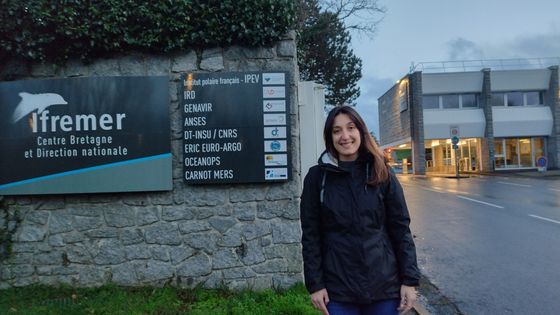
One of the best parts of being a scientist in my opinion is to go abroad, meet new researchers and discuss ideas. It is amazing to see what other scientists are doing and how different the institutes are. Last year I had the opportunity to go to Ifremer (Institut français de recherche pour l'exploitation de la mer), in Brest, Brittany, France, and all started with a simple email to Claire Ménesguen introducing myself and asking whether I could visit the institute.
Claire is one of the team leaders of the Ocean Scale Interactions group at the Laboratory for Ocean Physics and Satellite remote sensing (LOPS) together with Jonathan Gula. The main focus of the group is to study ocean dynamics with a particular interest in small horizontal and temporal scales. Once the collaboration was settled and I arrived in Brest, we had several meetings to start planning the structure of the upcoming work. The infrastructure at Ifremer is great, and I met many PhD students and posdocs. As the time and work progressed, we decide to slightly modify our initial plan. Science is highly non-linear, so we had to adapt given the results we obtained with some of the analyses. The good part about that is that I was able to constantly discuss not only with Claire (and Jeff), but also with a lot of people from both Ifremer and LOPS. Because people have different backgrounds, we were able to approach my research topic from many different angles, which led to many nice ideas.
Apart from work (because it would be a shame not to enjoy Brittany’s landscape), I enjoyed the weekends hiking and traveling to small cities around Brest, and, of course, eating! Brittany is very well-known for crêpes, sea food (oysters!) and caramel, which are musts to try when you are there. Brest is on the west coast of France and the landscape is just stunning! The color of the water, the lighthouses and the shape of the coast make this city quite unique. There is also an Aquarium which is really worth visiting. One curiosity from there is that they have their own language (Breton, or Brezhoneg), although nowadays French is the main language spoken. Another curiosity is that it rains a lot, and the weather can easily change from heavy storm to shining sun in a matter of hours.
After my return, Claire and I are still in close contact and we are already planning the next steps regarding our collaborative research. My time there was really pleasant and fruitful and a second research stay is planned in October 2023. I really recommend sometime abroad for everyone especially because the TRR provides the most difficult thing to get: money. This is a unique opportunity to gather different opinions about one’s research topic and to get people to know you too. I left behind many open doors and I am really excited to continue working with all the people I met!
Upper-ocean energy spectrum, flux & dissipation
The use of a new technology combined with new sampling algorithms potentially offers unprecedented insights into deep ocean mixing and internal wave climate.
Hi! My name is Ilmar and I work as a PhD student at the MARUM/University of Bremen. I am supervised by Dr. Maren Walter (MARUM/University of Bremen) and Dr. Alexa Griesel (Universität Hamburg) and am part of the TRR subprojects L3
entitled “Meso- to Submesoscale Turbulence in the Ocean” and W5 „Internal Wave Energy Dissipation and Wavenumber Spectra: Adaptive Sampling in the Ocean Interior “.
Before I joined TRR, I lived in Kiel, where I got a bachelor degree in Physics of Earth and master degree in Climate Physics: Meteorology and Physical Oceanography at Christian Albrechts University Kiel & GEOMAR. I started my work as a part of TRR in September 2022.
In the first phase of L3, we assessed turbulence regimes with a focus on the Benguela upwelling region. Using a new scaling method and with adequate subsampling of the deployed surface drifters, we estimated a consistent energy transfer rate and identified an inverse cascade for scales 30-500 km close to the upwelling current. Now Our aim in the second phase is to extend the Lagrangian analyses and apply the structure-function diagnostic (in addition to the classical Lagrangian dispersion estimates) in an area offshore from the Benguela region that is characterized by high internal tide and eddy activity but without a deep baroclinic current. In a concerted effort (targeted measurements with gliders, ship ADCP, drifters) we will quantify horizontal wavenumber spectra for the upper ocean in the Walvis Ridge Region in close collaboration with W5 and W2. The subsampling methods developed from the analyses in the Benguela and Walvis Ridge regions, together with high-resolution modelling, will be used to extrapolate to the global ocean using the global drifter program.
The W5 Project is concerned with the shape of the internal wave energy spectrum, where our aim is to simultaneously observe the oceanic energy spectrum below the submesoscale range and the spatial distribution of energy dissipation, using adaptive/reactive sampling to guide the observations. For this purpose, we will deploy a new hybrid pelagic glider (developed by Prof. Ralf Bachmayer) using an innovative approach of combining advanced numerical model informed sampling techniques in real-time to observe internal wave spectra and turbulence in the ocean interior. As a key sensor, a pressure rated microstructure probe will be integrated into the pelagic glider system; this use of a new technology combined with new sampling algorithms potentially offers unprecedented insights into deep ocean mixing and internal wave climate. Obtained observational data will be contextualized by idealized and regional numerical modelling studies carried out in L3 and L2 and the results of this project will complement the observations, that will be jointly used to construct the upper- and pelagic oceanic energy spectrum within L3, and the observations towards obtaining a local energy budget.
Diurnal Warm Layers and Rain Layers: Dynamics, Turbulence and Atmospheric Feedbacks
My work so far has been to simulate idealized cases using a 1D turbulence model.
Hello everyone, my name is Mira, I am a PhD at the Institute for Baltic Sea Research in Warnemünde and working in subproject L4, supervized by Lars Umlauf. To start off with something about myself: I studied physics at the University of Göttingen with a focus on Astro- and Geophysics during my masters. After an internship on sea ice physics at the University of Otago in New Zealand, I studied double-diffusive convection during my master thesis.
I love hiking and backpacking, so before, during and after my studies I spent a lot of time abroad, travelling, discovering new countries and meeting interesting people. When the pandemic started I had to change my plans and, by a chain of coincidences, started this phd position, which I am very happy about. I very much enjoy to live this close to the ocean and I spend a lot of time by the beach.
The focus of my project is on diurnal warm layers and rain layers on the ocean surface. These thin, stratified layers influence air-sea fluxes and turbulence in the ocean interior, but are usually not resolved in climate models. My work so far has been to simulate idealized cases using a 1D turbulence model. With that I can identify the non-dimensional parameters that govern these processes and perform parameter space studies, which can be the basis for a parameterization. I also work in close collaboration with Mira Shevchenko and Cathy Hohenegger, who study diurnal warm layers and their effect on the atmosphere using the coupled ICON model.
An In-Depth Study of Diurnal Warm Layers: Quantification of Air-Sea Interactions
I am fascinated by such theoretical results but also by their various fields of application.
In July 2021 I joined the TRR 181 as a postdoctoral researcher in the project L4, “Energy-Consistent Ocean-Atmosphere Coupling”. Within this project I am studying the phenomenon of diurnal warm layers (DWLs) in the ocean. It describes the warming of the sea surface in certain areas during daytime (by up to 2K, though in particular cases also higher fluctuations have been observed) compared to the surrounding ocean that usually keeps an almost constant surface temperature.
From the point of view of air-sea interactions the appearance of DWLs is of particular interest, since such differential heating can promote a sea breeze like convective movement and, as a result, serve as a cloud building mechanism. Moreover, as such warm spots appear due to solar radiation, one can also expect a feedback behaviour caused by an increase in the cloud cover.
The presence of DWLs as well as their influence on the cloud amount is well documented in the literature, at least in the qualitative sense. Moreover, this phenomenon has been confirmed in idealised simulation studies. However, most modern global coupled simulations do not capture this mechanism, since it requires a high vertical resolution of the sea levels in order to correctly represent the heat transport (involving only about 20m in the vertical), but also a high horizontal resolution in the atmosphere that would permit to directly resolve convection. My work in the project consists in implementing a simulation that would incorporate both these features. This has been made possible thanks to recent model development advances for the ICON models at the Max Planck Institute for Meteorology. A subsequent analysis of the output will improve the understanding of the phenomenon itself, in particular permitting to quantify the feedback mechanisms, but it will also clarify how significant of an influence the correct representation of DWLs has on the global cloud amount, and, as a consequence, on the climate described by the simulation. Such results would, moreover, enable a parametrisation of this phenomenon such that it can be included in lower resolution models in order to improve their performance.
Within the project L4 I work under supervision of Cathy Hohenegger at the MPI for Meteorology and collaborate mainly with Nils Brüggemann, Lars Umlauf and Mira Schmitt who already implemented a set of thin layer ocean simulations and contributed significantly to my understanding of the mechanisms involved.
Prior to joining the TRR 181 I spent several years doing research in Probability Theory. After obtaining my Master’s degree at the HU Berlin I went on to complete my PhD at the TU Dortmund with a research stay at the University of Lille. During my doctorate I studied stochastic (partial) differential equations driven by random processes or fields with long memory, i.e. such that the increment correlation decays only slowly over time. An example is the fractional Brownian motion. Using techniques from the Malliavin-Stein toolkit (providing a definition for multiple stochastic integrals with respect to Gaussian processes and many limiting results for those) I proved in several collaborations limit theorems for certain functionals of the solutions of such equations. From the practical point of view, this enabled me to derive results in mathematical statistics and provide estimators for different quantities in such equations as well as show their asymptotic properties.
After defending my dissertation I stayed at the TU Dortmund as a postdoctoral researcher. During this time I studied (in another collaboration) random fields on a sphere. Such objects are used in cosmology to describe cosmic microwave background, but they can also be applied to analyse other random spherical observations such as, for instance, temperature defects.
I am fascinated by such theoretical results but also by their various fields of application. I hope to be able to use some of the models that I studied in order to assess the impact of DWLs and/or to describe other phenomena in the atmosphere and ocean that would help advance the understanding and modelling of physical processes on different scales.
The Impact of Submesoscales on the Air-Sea Exchange
I will investigate on the potential impact of submesoscale dynamics on the sea surface temperature or the influence of wind on instabilities at ocean fronts.
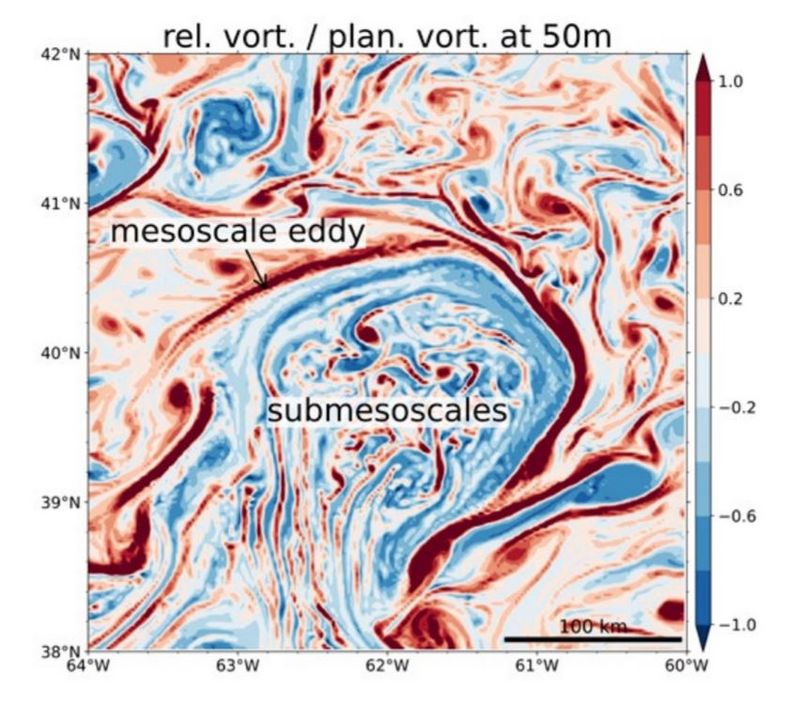
Hello everyone, my name is Moritz Epke and I am pleased to give you a small impression of my work at TRR. I am part of the subproject L4 „Energy consistent ocean atmosphere coupling”, which investigates small scale and balanced processes and their impact on feedback mechanism between atmosphere and ocean. Before I go into more detail, maybe a few words about my background. I moved to Hamburg to study theoretical mechanical engineering at the Hamburg University of Technology. My interest in the physics of fluids grew and grew through my studies and drove me to focus on this topic and related numerical solution approaches. In my thesis I developed and implemented a lattice Boltzmann scheme to efficiently simulate non-isothermal flows, which I benchmarked on standard testcases like Rayleigh-Bénard convection in a cavity and which I used to simulate the internal cooling of a turbine blade by a turbulent flow.
While most engineering applications have setups with scales from less than a centimeter as in a pipe flow, or up to a few hundred meters as in a large ship, the ocean and the atmosphere have scales that are orders of magnitude higher. Even if we make use of clever approximation techniques to simplify the governing equations in order to reduce the computational effort, we can only carry out coupled climate simulations with roughly tenkilometer (ocean) grid spacing on a modern supercomputer. In such a simulation an 80km ocean eddy would only be coarsely resolved. The computational surplus to resolve more scales in long-term simulations is simply too high. What cannot be resolved is usually parameterized or neglected. If parameterized, a model is developed which is based at best on a physical relationship between the relevant parameters. These parameterizations are then tested and optimized in idealized or regional setups. If now such parameterizations or insufficient parameterizations are used, the model is most likely subject to biases. These types of biases might have a strong impact on the energy consistency.
In the first phase of my PhD I am using an ICON submesoscale telescope simulation, which is based on an unstructured grid and allows us (for a short time period) to use an extremely fine spatial resolutions of up to 600m in the focus region. If we look again at an 80km ocean eddy, which is now well resolved, we can see small scale coherent structures that we associate with the submesoscale (see figure) and define to be smaller than the first baroclinic Rossby radius of deformation. It is an objective to understand and quantify the impact of submesoscale dynamics like baroclinic and symmetric instabilities on the downward heat and energy transfer and their role for ocean-atmosphere interactions. Here, I will investigate on the potential impact of submesoscale dynamics on the sea surface temperature or the influence of wind on instabilities at ocean fronts. Therewith, I aim to obtain a better understanding of submesoscale dynamics and their role in the coupled ocean-atmosphere system. This improved understanding might ultimately lead to improved parameterizations and therewith less biases in the coupled climate models.
Decomposition of Vertical Momentum Fluxes in the Tropical Atmosphere
Based on MODES we will develop a tool for the computation of vertical momentum fluxes from high-resolution ERA5 data.
Greetings dear reader! My name is Valentino and I work as a PhD student at the University of Hamburg under the supervision of Dr. Nedjeljka Žagar (Universität Hamburg). I am a part of the TRR subproject L2 named “Quantifying Dynamical Regimes in the Ocean and the Atmosphere”. I am originally from Croatia where I spent all of my education years. I have Bachelor in Physics/Geophysics from the University of Zagreb and a Masters in Meteorology and Physical Oceanography that I acquired with the thesis on “Implementation of the empirical orthogonal functions analysis to determine nonstationarity of time series” from the University of Zagreb.
I started my work as a part of TRR in May of 2021. with the goal of my work being the quantification of vertical momentum fluxes in the tropical atmosphere. To do this we will employ normal mode decomposition ( NMD ) to decompose atmospheric motions to different dynamical regimes. More precisely we will be using the MODES NMD package developed by Žagar et al., for the horizontal velocity and an associated novel spectral approach for the vertical velocity decomposition. Based on MODES we will develop a tool for the computation of vertical momentum fluxes from high-resolution ERA5 data.
Then, we will analyze climate models in the same way and compare the results with those for reanalysis to quantify missing momentum fluxes across scales. The results will be then used to quantify the missing momentum fluxes in climate models that are still running at a much lower resolution. The quantification of vertical momentum fluxes associated with the inertiagravity waves in analysis data can become valuable validation metrics of new parameterizations and upscale transfers in ICON-a and other climate models. The results will provide, among others, a novel scaledependent quantification of the vertical momentum fluxes associated with different atmospheric regimes in analyses and climate models.
Models, Respecting the Conservation Laws
Recently we have learned how to combine the framework with stochastic turbulent closures, thereby making another step towards realistic turbulence models.
Ideal (i.e. non-dissipative) fluids are characterized by a number of conservation laws, which are the defining features of the motion, such as
- energy conservation;
- mass conservation;
- material conservation of generalized vorticity, e.g. potential vorticity,
- model specific advected quantities, for instance, potential temperature in inviscid primitive equations.
In many applications the dissipation can not be ignored, whereupon all of the above laws must be modified appropriately. However, in order to establish the ideas, it is useful to stick to the non-dissipative case initially. My work in TRR 181 is focused on developing “simplified” models that inherit the conservation laws from their parent system. This branches into two distinct sub-projects.
1. Lagrangian turbulence models. Common approach to turbulence modeling is based upon averaging the equations of motion at each spatial location (e.g. Reynolds averaging). While very natural, this approach destroys material conservation laws. This can be remedied by using more elaborate procedures, known as Lagrangian averaging, based on averaging fluid parcels’ trajectories. Combining the recently introduced concept of geometric generalized Lagrangian mean (geometric GLM) with averaging of the variational principles, we developed a turbulence framework, which guarantees the inheritance of the above conservation laws by the model.
Using this framework, we derived a number of idealized turbulence models, namely for the primitive and Euler-Boussinesq equations, Euler’s equations of ideal fluid flow, and the multi-dimensional Burgers’ equations. While working on these models, we found that our framework is highly adaptable to different physical contexts (compressible and incompressible flows, manifolds, various boundary conditions, anisotropy are all treatable within the framework) and leads to models with desirable mathematical properties (well-posedness, filtering of small scales). Another advantage is that the framework is not bound to a particular choice of scalar-averaging (e.g. time-averaging or statistical averaging). Recently we have learned how to combine the framework with stochastic turbulent closures, thereby making another step towards realistic turbulence models.
The bulk of work done up to now provides a proof of concept for our methodology. Several steps still need to be taken, in order to make the concept attractive to applied scientists. One is the inclusion of dissipation. Another avenue is further adapting the framework to a specific physical context (for instance, incorporating the concept of isopycnal averaging for the ocean models) and developing corresponding parametrizations in the closure.
Three papers so far were written for this sub-project: one is published, one is submitted, and one is in preparation.
2. Variational approximations for rescaled fluid models. A powerful method of studying equations of mathematical physics is rescaling of equations of motion followed by their asymptotic analysis. However, when applied to Lagrangian system, this approach has an important drawback as it potentially destroys the variational structure of the problem and associated conservation laws.
How to construct asymptotic approximations to the rescaled equations that yield models inheriting conservation laws 1)-4) from the parent system then? The answer is fairly straightforward for an isotropic scaling and is based on first approximating the rescaled variational structure, then computing the equations of motion. However, for anisotropic scaling, the rescaled variational structure becomes more complex and not all its approximations have the desired property.
We completely resolved the question for inviscid homogeneous fluids, thereby developing a systematic procedure for constructing conservation laws-preserving approximations to the rescaled systems. It turns out that many known models are trivial to derive using our framework. For instance, the inviscid primitive equations fall within the framework as an approximation to Euler-Boussinesq system.
The problem that initiated this project comes from equatorial dynamics. There is much theoretical interest in the dynamics of planetary-scale Kelvin waves for the purpose of atmospheric and oceanic data assimilation. This calls for a geophysical balance model, which retains equatorial Rossby waves in addition to Kelvin waves. The work on deriving the required balanced model is about to begin. Another direction of our research is to obtain models of front-formation in atmosphere and ocean due to strong meridional temperature gradients. Further applications are likely as the framework should prove useful whenever approximate models are sought in an anisotropic setting.
The theoretical paper for this sub-project will be submitted for publication in the nearest future. Two further papers on equatorial balance models and front-formation models are planned.
Spontaneous Waves and Dissipation
To identify spontaneously emitted waves in a more or less realistic setting I use a high resolution global ocean model.
Hi, my name is Thomas, I am a PhD Student in subproject L2 “The interior energy pathway: internal wave emission by quasi-balanced flows” at the Max-Planck-Institute for Meteorology. This project tries to answer the question to what extend spontaneous wave generation contributes to the ocean’s route to dissipation.
The ocean’s route to dissipation is not yet fully understood. Both the large-scale currents and the meso-scale eddies in the ocean are essentially balanced. Moreover, those eddies tend to transfer energy upward towards larger scales. So the question arises how the energy is transported from the large scales to the small scales, where the energy can be dissipated. Spontaneously emitted waves can be refracted by the eddying flow and captured later. Wave capture is a possible way to transfer energy to smaller scales. I am contributing to this question by identifying spontaneously emitted waves in an OGCM.
To identify spontaneously emitted waves in a more or less realistic setting I use a high resolution global ocean model. The model runs in two configurations: One is a realistic setting forced by 6-hourly atmospheric fluxes obtained by reanalysis data and a second one with temporally constant forcing. By comparing the two simulations I found wavelike structures which are not generated by external forcing but by the eddying flows itself. The properties of these structures identify them as gravity waves which are likely to be generated by spontaneous emission. Further analysis may show to what extend these waves contribute to the ocean’s route to dissipation.
Balance-imbalance decomposition of the flow field
We are currently working on application of the optimal balance algortihm to the shallow water model and the primitve equations will follow.
I am a PhD student in the subproject L2 at Jacobs University Bremen under supervision of Prof. Marcel Oliver.
Our role in the subproject can be briefly explained as follows: In large-scale ocean models, the ocean circulations are essentially balanced; however, this balance breaks down in small scales due to spontaneous generation of inertia-gravity waves by quasi-balanced circulations, and waves are maybe re-captured in later times. This spontaneous emission and wave capture is considered to contribute to the energy transfer from the essentially balanced large-scale circulation and mesoscale eddy fields down to smaller scales, which is a route to dissipation.
To analyse the role of inertia-gravity waves in interior dissipation, a reasonable approach is to diagnose the inertia-gravity waves by splitting the flow field into balance and imbalance components, which are the ocean circulation and the inertia-gravity waves, respectively. This balance-imbalance decomposition can be achieved by some diagnostic tools such as linear time filters, balance relations, and optimal potential vorticity balance. In this project, we want to provide a new numerical algorithm to separate spontaneously generated imbalanced flows from the vertical flows depending on a prior work called „optimal balance“.
We are currently working on application of the optimal balance algorithm to the shallow water model and the primitive equations will follow. The “optimal balance” algorithm is interesting to us not only for practical aspects but also mathematical features, so that we extensively worked on asymptotics-preserving schemes on a finite dimensional model in the algorithm. There are several other theoretically open questions, which are standing for the algorithm as its existence and uniqueness, to be considered.
